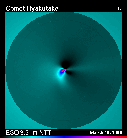Comet Hyakutake - Update (March 25, 1996)
Read More:

Dust Jets (ESO NTT Image)
This is a brief update to my earlier summaries about observations of this comet, published on the ESO Web on March 12 and March 22 . It is based on information received directly by email and also from IAU Circulars and on other Hyakutake WWW pages.
Richard M. West (ESO)
March 25, 1996; 10:00 UT
Hyakutake at the time of the closest approach
The comet passed closest to the Earth this morning at about 07:00 UT (08:00 MET). At that time, it was about 15.26 million km from our planet.
Visual sightings have been reported during the past two days from almost all countries in the Northern Hemisphere (except some where the weather has been particularly uncooperative). The appearance of the comet has been described with superlatives by many experienced amateur astronomers.
For instance, Charles Morris in California reports that the comet is now a 0.2 magnitude object and has a 40 degree tail: 1996 Mar. 22.47 UT: m1=0.2, Dia.=80', DC=8, Tail: 40 deg in PA ~240...NE.... Charles Morris (Gorman, CA) [This is the most unbelievable sight that I have ever seen in the sky. Where to begin...To the naked eye, the motion of the comet was obvious in a matter of minutes...in fact, there was a sense of motion just looking at it. The tail was much brighter than three mornings ago - the last time I saw the comet without clouds around. The first 15 degrees of the tail is quite bright. The rest is much fainter, but there. In the 26cm L (45x), the individual rays from the gas tail were followed out at least five degrees - a first for me. Using 156x, there was a prominent jet coming out of the intense central condensation. It was directed back toward the tail. (This was not the tail, itself.) Two other jets or brighter regions around the central condensation were also seen.]
The reports from the past 24 hours indicate a total magnitude of +0.9 to -0.1; the true value is probably 0.5 - 0.3. The central condensation has been compared in brightness with the stars in the Big Dipper (mag 2 - 3). The coma diameter is 1.5 - 2.2 degrees, i.e. 3 - 4 times the diameter of the Moon. The visible length of the ion tail is critically dependent on the darkness of the observing site; values between 15 and 70 degrees were reported. There have been no reports about a significant dust tail.
New tail and coma predictions have become available by David Lien.
Comet Hyakutake has already served at least one very useful educational programme, as shown by the following successful Danish-Portuguese collaboration (within the auspices of the European Association for Astronomy Education) to determine the comet's distance. On March 21, 16 - 18 years old students at two high schools in Soenderborg (Denmark) and Lisbon (Portugal) pointed their CCD-equipped telescopes towards Hyakutake at exactly the same time. Since the comet was so close to the Earth, around 22 million km, the geographical distance between the two cities, nearly 3000 km, induces a shift in the comet's position of more than 20 arcseconds, as seen from the two sites. This displacement is easy to measure on the CCD frames and will allow a direct determination of the distance to the comet. This is the so-called parallax method which was used already by Tycho Brahe and his contemporaries to estimate the distance to the comet of the year 1577.
The orbit
An updated ephemeris (March 22) by Don Yeomans is now available. The current orbital period is now about 18,500 years.
Planned Observations
On March 23, John A. Farrell informs that we will attempt high-resolution imaging of Comet Hyakutake at the U.S. Air Force Starfire Optical Range during the next three nights. The instrument is a 1.5m telescope equipped with adaptive optics and a laser beacon for wavefront sensing which has achieved resolutions close to 0.1 arcsec. We will also use the 3.5m telescope but its adaptive optics is not yet operational. If successful, the images will be posted as quickly as possible at http://wwwsor.plk.af.mil.
Comments by the discoverer
We have received the following statement by Yuju Hyakutake about his discovery and how it feels to have found one of the most spectacular comets of all time.
My heartiest congratulations to Yuji Hyakutake for this great discovery! And thanks for having helped all comet enthusiasts to this wonderful sight!